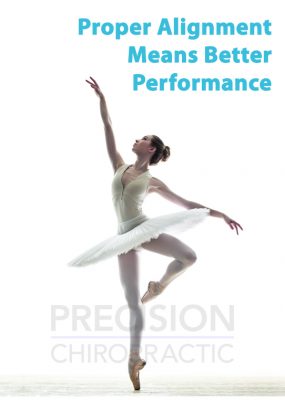In this first part of our Performance series, we explore how chiropractic can help dancers be at their best both on and off the stage.
While most people associate chiropractic care with back pain, more and more dancers rely on chiropractors to not only treat problems that often arise but to help dancers perform at their optimal best [1]. Dancers are routinely placing their bodies under strain and must be in peak physical condition not only from a strength and fitness perspective, but also when it comes to the mind-body connection and how the brain is controlling the various elements within the musculoskeletal frame.
Dancing requires coordination and balance, which stem from a combination of strong muscles, ligaments and bones, along with a clear and accurate line of communication between the brain and the body. Having abnormal structural alignment in your spine and body can cause the signals between the brain and the body to be impaired. Which, for dancers, can result in not just the muscles and joints working harder than they should, but their artistic expression suffering if they aren’t functioning at their best.
Grace, fluidity, and mobility are not created overnight, and repeatedly practicing movements can result in damage over time; especially if there are imbalances or weaknesses for which the body tries to compensate. It’s important to reduce these imbalances as much as possible so that the body can direct it’s resources to the areas that are under pressure from the dance form itself. For example, a study on ballet dancers reported that 76% of their injuries occurred in the lower extremities [3], whereas a study on break dancers showed that the majority (69%) of their injuries were in the wrist [5]. Different dance forms place different areas of the body under strain, but if there is a structural shift in the body’s alignment, there are unnecessary strains on the structures of not only the spine, but also the rest of the body and the nerve system, which must work that much harder to then manage its normal structure and avoid injury.
For dancers, the normal structural alignment of their spine directly impacts the quality of their performance, lifespan of their career and overall wellbeing as a performing artist. Practicing movements and patterns time after time can lead to repetitive strains, which can affect a dancer’s ability to execute and focus on technique. Chiropractic care addresses biomechanical impairments that can cause or prolong injuries and helps the brain and body work together to keep dancers performing better for longer.
Curious about how chiropractic can take your dancing a leap further? Check out our Complimentary Chat
- Scott Howitt. Chiropractic Takes Centre Stage: Treating overuse injuries in the world of dance. Canadian Chiropractor. Retrieved from http://www.canadianchiropractor.ca/content/view/1098/
- Nilsson, et al. Spinal sagittal mobility and joint laxity in young ballet dancers.Knee Surgery, Sports Traumatology, Arthroscopy 1993; 1 (3-4), 206-208
- Charlotte Leanderson et al. Musculoskeletal injuries in young ballet dancers. Knee Surgery, Sports Traumatology, Arthroscopy 2011; 19 (9); 1531-1535
- Chul Hyun Cho, et al. Musculoskeletal injuries in break-dancers. Injury, Int. J. Care Injured 2009; 1207-1211
- Cho C, Song K, Min B, Bae K, Lee K, Kim S. Scaphoid Nonunion in Break-Dancers: A Report of 3 Cases. 1; 32
- Koutedakis Y, A Jamurtas. The Dancer as a Performing Athlete: Physiological Considerations. Sports Med 2004; 34 (10); 651-661.
- David Linford. Chiropractic Care – The Dance Advantage. 2017; Retrieved from http://linfordchiropractic.ca/chiropractic-care-the-dance-advantage/


0 Comments